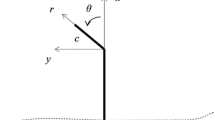Abstract
The elastic T-stress has been recognised as a measure of constraint around the tip of a crack in contained yielding problems. A review of the literature indicates that most methods for obtaining T are confined to simple geometry and loading configurations. This paper explores direct use of finite element analysis for calculating T. It is shown that for mode I more reliable results with less mesh refinement can be achieved if crack flank nodal displacements are used. Methods are also suggested for calculating T for any mixed mode I/II loading without having to calculate stress intensity factors. There is good agreement between the results from the proposed methods and analytical results. T-stress is determined for a test configuration designed to investigate brittle and ductile fracture in mixed mode loading. It is shown that in shear loading of a cracked specimen T vanishes only when a truly antisymmetric field of deformation is provided. However this rarely happens in practice and the presence of T in shear is often inevitable. It is shown that for some cases the magnitude of T in shear is much more than that for tension. The effect of crack length is also investigated.
Similar content being viewed by others
References
ABAQUS, V 5.6 (1996). User's Manual.Hibbitt, Karlsson and Sorensen Inc, Providence, Rhode Island.
Al–Ani, A.M. and Hancock, J.W. (1991). J–dominance of short cracks in tension and bending. Journal of the Mechanics and Physics of Solids 39(1), 23–43.
Betegon, C. and Hancock, J.W. (1991). Two–parameter characterization of elastic–plastic crack–tip fields. Journal of Applied Mechanics 58, 104–110.
Cardew, G.E., Goldthorpe, M.R., Howard, I.C. and Kfouri, A.P. (1984). On the elastic T–term. Fundamentals of Deformation and Fracture(Edited by B.A. Bilby, K.J. Miller and J.R. Willis), Cambridge University Press, Cambridge, UK, pp. 465–476.
Davenport, J.C.W. and Smith, D.J. (1993). A study of superimposed fracture modes I, II, III on PMMA. Fatigue and Fracture of Engineering Materials and Structures 16(10), 1125–1133.
Du, Z.Z., Betegon, C. and Hancock, J.W. (1991). J–dominance in mixed mode loading. International Journal of Fracture 52, 191–206.
Ewing, P.D, Swedlow, J.L. and Williams, J.G. (1976). Further results on the angled crack problem. International Journal of Fracture 12, 85–93.
Fett, T. (1997). A Green's function for T–stress in an edge–cracked rectangular plate. Engineering Fracture Mechanics 57(4), 365–373.
Haefele, P.M. and Lee, J.D. (1995). The constant stress term. Engineering Fracture Mechanics 50(5/6), 869–882.
Hallback, N. and Jonsson, N. (1996). T–stress evaluations of mixed mode I/II fracture specimens and T–effects on mixed mode failure of aluminium. International Journal of Fracture 76, 141–168.
Hancock, J.W., Reuter, W.G. and Parks, D.M. (1993). Constraint and toughness parameterized by T. Constraint Effects in Fracture, ASTM STP 1171(Edited by E.M. Hackett, K.–H. Schwalbe and R.H. Dodds), American Society for Testing and Materials, Philadelphia, pp. 21–40.
Kardomateas, G.A., Carlson, R.L., Soediono, A.H. and Schrage, D.P. (1993). Near tip stress and strain fields for short elastic cracks. International Journal of Fracture 62, 219–232.
Kfouri, A.P. (1986). Some evaluations of elastic T–term using Eshelby's method. International Journal of Fracture 30, 301–315.
Kirk, M.T., Koppenhoefer, K.C. and Shih, C.F. (1993). Effect of constraint on specimen dimensions needed to obtain structurally relevant toughness measures. Constraint Effects in Fracture, ASTM STP 1171(Edited by E.M. Hackett, K.–H. Schwalbe and R.H. Dodds), American Society for Testing and Materials, Philadelphia, pp. 79–103.
Knesl, Z. (1995). Evaluation of the elastic T–stress using a hybrid finite element approach. International Journal of Fracture 70, R9–R14.
Larsson, S.G. and Carlsson, A.J. (1973). Influence of non–singular stress terms and specimen geometry on small–scale yielding at crack tips in elastic–plastic materials. Journal of the Mechanics and Physics of Solids 21, 263–277.
Leevers, P.S. and Radon, J.C. (1982). Inherent stress biaxiality in various fracture specimens. International Journal of Fracture 19, 311–325.
Olsen, P.C. (1994). Determining the stress intensity factors KI, KII and the T–term via the conservation laws using the boundary element methods. Engineering Fracture Mechanics 49(1), 49–60.
R6A14 (1995). Assessment of the integrity of structures containing defects. R/H/R6–Revision 3, Appendix 14, Nuclear Electric Plc., UK.
Richard, H.A. (1989). Specimens for investigating biaxial fracture and fatigue processes. Biaxial and Multiaxial Fatigue(Edited by M.W. Brown and K.J. Miller)Mechanical Engineering Publications, London. pp. 217–229.
Seed, G.M. and Nowell, D. (1994). Use of the distributed dislocation method to determine the T–stress. Fatigue and Fracture of Engineering Materials and Structures 17(5), 605–618.
Sham, T.–L. (1991). The determination of the elastic T–term using higher order weight functions. International Journal of Fracture 48, 81–102.
Sherry, A.H., France, C.C. and Goldthorpe, M.R. (1995). Compendium of T–stress solutions for two and three dimensional cracked geometries. Fatigue and Fracture of Engineering Materials and Structures 18(1), 141–155.
Sladek, J., Sladek, V. and Fedelinski, P. (1997). Contour integrals for mixed–mode crack analysis: effect of nonsingular terms. Theoretical and Applied Fracture Mechanics 27, 115–127.
Sorem, W.A., Dodds, R.H. and Rolfe, S.T. (1991). Effects of crack depth on elastic plastic fracture toughness. International Journal of Fracture 47, 105–126.
Sumpter, J.D.S. (1993). An experimental investigation of the Tstress approach. Constraint Effects in Fracture, ASTM STP 1171(Edited by E.M. Hackett, K.–H. Schwalbe and R.H. Dodds), American Society for Testing and Materials, Philadelphia, pp. 492–502.
Williams, M.L. (1957). On the stress distribution at the base of a stationary crack. Journal of Applied Mechanics 24, 109–114.
Author information
Authors and Affiliations
Rights and permissions
About this article
Cite this article
Ayatollahi, M., Pavier, M. & Smith, D. Determination of T-stress from finite element analysis for mode I and mixed mode I/II loading. International Journal of Fracture 91, 283–298 (1998). https://doi.org/10.1023/A:1007581125618
Issue Date:
DOI: https://doi.org/10.1023/A:1007581125618




